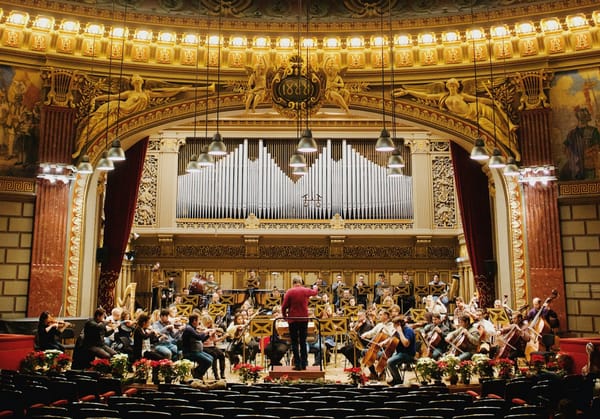Introducing Classical Music to Kids: A Guide to Nurturing Young Ears
Classical music can enrich a child’s development, enhancing creativity, focus, and emotional intelligence. This guide explores engaging ways to introduce children to classical music, from interactive listening activities to famous compositions that spark curiosity and joy.

Classical music has long been associated with cognitive and emotional benefits, particularly for children. From improving concentration and memory to fostering creativity and emotional intelligence, its impact is profound. However, introducing children to classical music requires a thoughtful and engaging approach. Unlike pop or nursery rhymes, classical music often lacks immediate familiarity, but with the right methods, it can become an enriching and enjoyable part of a child's life.
In this guide, we will explore how to introduce children to classical music in a way that captivates their imagination and enhances their development. From fun listening activities to age-appropriate recommendations, we will highlight the best ways to cultivate a lifelong appreciation for classical music.
Why Classical Music is Beneficial for Kids
1. Cognitive Development
Numerous studies suggest that classical music enhances cognitive functions in children. The "Mozart Effect," for instance, posits that listening to Mozart’s compositions can temporarily improve spatial reasoning skills. While this theory has been debated, research consistently shows that exposure to classical music aids in problem-solving, pattern recognition, and memory retention.
Children who engage with classical music from a young age tend to develop stronger linguistic skills, better mathematical abilities, and improved concentration. The structure and complexity of classical compositions stimulate the brain, encouraging cognitive flexibility and deeper analytical thinking.
2. Emotional Intelligence and Expression
Classical music conveys a broad range of emotions, helping children develop empathy and emotional awareness. Pieces like Tchaikovsky’s Swan Lake or Beethoven’s Moonlight Sonata express sadness, while Vivaldi’s Spring from The Four Seasons radiates joy. Encouraging children to recognise and discuss these emotions fosters emotional intelligence and self-expression.
3. Creativity and Imagination
Unlike music with lyrics, classical compositions allow children to form their own interpretations. They can imagine stories, characters, or landscapes while listening, nurturing their creativity. Many classical pieces have inspired ballets, films, and theatre productions, demonstrating how music can fuel the imagination in multiple artistic disciplines.
4. Improved Focus and Relaxation
Studies show that classical music can enhance concentration, making it an excellent background for reading, studying, or creative activities. Slow-tempo pieces, such as Debussy’s Clair de Lune, can also promote relaxation and reduce anxiety, making them ideal for bedtime routines.
How to Introduce Classical Music to Kids
1. Make It Fun and Interactive
The key to engaging children with classical music is to make it enjoyable. Passive listening may not always capture their attention, so incorporating interactive elements can help.
Ideas for Interactive Listening:
- Storytelling with Music: Choose a piece and encourage your child to create a story based on the sounds they hear. For example, Saint-Saëns’ The Carnival of the Animals lends itself beautifully to imaginative storytelling.
- Movement and Dance: Play energetic pieces like Rossini’s William Tell Overture or Strauss’ The Blue Danube and encourage children to move or dance to the rhythm.
- Drawing and Painting: Ask your child to draw what the music makes them feel or imagine. Pieces such as Mussorgsky’s Pictures at an Exhibition work wonderfully for this activity.
- Call and Response Games: Play short excerpts and encourage children to mimic rhythms or hum melodies, making it a fun auditory exercise.
2. Choose Age-Appropriate Music
Children respond best to music that is engaging, dynamic, and varied. Below are recommendations based on age groups:
Ages 0-3: Gentle and Melodic
At this stage, children are highly receptive to soothing sounds. Classical lullabies and gentle pieces can create a calming environment.
- Recommended Pieces:
- Brahms’ Lullaby
- Debussy’s Clair de Lune
- Schumann’s Kinderszenen (Scenes from Childhood)
Ages 4-7: Playful and Imaginative
Young children enjoy music that tells a story or has distinct, recognisable themes.
- Recommended Pieces:
- Saint-Saëns’ The Carnival of the Animals
- Prokofiev’s Peter and the Wolf
- Tchaikovsky’s The Nutcracker Suite
Ages 8-12: More Complex and Expressive
Older children can appreciate more intricate compositions and dramatic storytelling in music.
- Recommended Pieces:
- Beethoven’s Symphony No. 5
- Holst’s The Planets
- Rimsky-Korsakov’s Flight of the Bumblebee
3. Introduce Classical Music Through Media
Children are often introduced to classical music through cartoons, films, and television. Many classical pieces are featured in well-known animations and movies:
- Disney’s Fantasia (featuring The Sorcerer’s Apprentice by Dukas, Beethoven’s Symphony No. 6, and Stravinsky’s The Firebird Suite)
- Looney Tunes cartoons (The Barber of Seville by Rossini, Ride of the Valkyries by Wagner)
- Films like Harry Potter (influenced by romantic and neoclassical styles)
By pointing out classical music in their favourite shows, children can develop an organic appreciation for it.
4. Attend Live Performances or Virtual Concerts
Experiencing live music can leave a lasting impression on children. Many orchestras offer family-friendly concerts designed to introduce young audiences to classical music in an engaging way. If live performances are not accessible, many orchestras and opera houses provide free online streams of concerts tailored for children.
5. Encourage Participation in Music-Making
Learning to play an instrument fosters a deeper connection with classical music. Many children start with the piano or violin, but any instrument can be a gateway into the world of classical music. Even simple activities like clapping rhythms or singing along to melodies encourage musical engagement.
Overcoming Common Challenges
“Classical Music is Boring”
Some children might initially find classical music slow or unfamiliar. To counter this:
- Start with short, engaging pieces before introducing longer symphonies.
- Choose lively compositions with strong rhythms and melodies.
- Present classical music in a fun and visual way, such as through dance or cartoons.
“It’s Too Complicated”
Classical music can seem complex, but breaking it down into recognisable elements makes it approachable. Help children identify different instruments, moods, or rhythms to make it more accessible.
Maintaining Interest Over Time
Building a love for classical music is a gradual process. Keep the experience fresh by exploring different composers, styles, and interactive activities. Celebrate milestones, such as recognising a piece they heard in a film or learning to play a simple melody on an instrument.
Conclusion
Introducing children to classical music is a rewarding journey that fosters cognitive, emotional, and creative growth. By making the experience interactive, age-appropriate, and relevant to their interests, classical music can become a source of joy and inspiration in their lives. Whether through storytelling, movement, film, or live performances, classical music offers a world of discovery for young listeners. With patience and creativity, children can develop a lifelong appreciation for this rich and beautiful art form.





